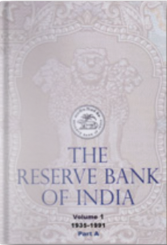 IST,
IST,


Our History
History of any institution aims at documenting, collating, compiling and presenting a comprehensive, authentic and objective study of the working of that institution, the events, the policies, the institutional development of the organisation. The institutional history of the central bank reflects, in some ways, the monetary history of the country, bringing down to concrete and human terms the policies, the considerations, the mistakes, the thought processes, the decision making and the broader canvas of political economy of the times.
The history of Reserve Bank of India thus not only traces the evolution of the central banking in India but also serves as a work of reference and an important contribution to the literature on monetary, central banking and development history of India. We have so far published five volumes of our history.

Volume 1
- (1935-1951)
The Reserve Bank of India was set up on April 1, 1935. It is one of the few central banks to document its institutional history. So far, it has brought out five volumes of its history. Volume 1, covering the period from 1935 to 1951, was published in 1970. It details the initiatives taken to put in place a central bank for India and covers the formative years of the Reserve Bank. It highlights the challenges faced by the Reserve Bank and the Government during World War II and the post-independence era.
The Reserve Bank of India was set up on April 1, 1935. It is one of the few central banks to document its institutional history. So far, it has brought out five volumes of its history. Volume 1, covering the period from 1935 to 1951, was published in 1970. It details the initiatives taken to put in place a central bank for India and covers the formative years of the Reserve Bank. It highlights the challenges faced by the Reserve Bank and the Government during World War II and the post-independence era.

Volume 2
- (1951-1967)
Volume 2, covering the period from 1951 to 1967 was published in 1998. This period heralded an era of planned economic development in India. This volume captures the initiatives taken to strengthen, modify and develop the economic and financial structure of the country. Apart from the Reserve Bank’s role as the monetary authority, it highlights the endeavour to establish an institutional infrastructure for agricultural and long-term industrial credit in India. This volume succinctly covers the external payment problems faced by the country and the rupee devaluation of 1966.
Volume 2, covering the period from 1951 to 1967 was published in 1998. This period heralded an era of planned economic development in India. This volume captures the initiatives taken to strengthen, modify and develop the economic and financial structure of the country. Apart from the Reserve Bank’s role as the monetary authority, it highlights the endeavour to establish an institutional infrastructure for agricultural and long-term industrial credit in India. This volume succinctly covers the external payment problems faced by the country and the rupee devaluation of 1966.

Volume 3
- (1967-1981)
On March 18, 2006, Hon’ble Prime Minister, Dr. Manmohan Singh released the third volume of the Reserve Bank’s history covering the period from 1967 to 1981. An important event of this period was nationalisation of fourteen banks in 1969, leading to spread of banking in country’s hinterland. The issues of safety and prudence in banking also gained prominence. Internationally, the abandonment of the Bretton Woods system in 1971 posed serious challenges for the developing countries including India. The volume also deals with the matters of co-ordination between the Reserve Bank and the Government.
On March 18, 2006, Hon’ble Prime Minister, Dr. Manmohan Singh released the third volume of the Reserve Bank’s history covering the period from 1967 to 1981. An important event of this period was nationalisation of fourteen banks in 1969, leading to spread of banking in country’s hinterland. The issues of safety and prudence in banking also gained prominence. Internationally, the abandonment of the Bretton Woods system in 1971 posed serious challenges for the developing countries including India. The volume also deals with the matters of co-ordination between the Reserve Bank and the Government.

Volume 4
- (1981-1997)
Volume 4 of the Reserve Bank’s history was also released by Dr. Manmohan Singh, Hon’ble Prime Minister of India on August 17, 2013. It covers the eventful 16 years from 1981 to 1997 and is published in two parts, Part A and Part B, which ideally should be read in continuum. Part A focuses on the transformation of the Indian economy from a regime of restrictions to progressive liberalisation. The 1980s were characterised by an expansionary fiscal policy accompanied by automatic monetisation of budgetary deficit that strained the conduct of monetary policy. Similarly, a highly regulated banking system impaired efficiency. The domestic macroeconomic imbalances combined with deteriorating external conditions triggered the balance of payments (BoP) crisis of 1991. Subsequent reforms ushered in far reaching changes not only in the economy but also in central banking. Part B of the volume captures the implementation of structural and financial sector reforms: fiscal correction and phasing out of automatic monetisation; development of government securities market; and greater integration among money, securities and foreign exchange markets. It also covers the transformation in banking with liberalisation and improvement in credit delivery. At the same time, the Reserve Bank had to contend with a securities scam which led to the introduction of better control systems and strengthening of the payment and settlement systems.
Volume 4 of the Reserve Bank’s history was also released by Dr. Manmohan Singh, Hon’ble Prime Minister of India on August 17, 2013. It covers the eventful 16 years from 1981 to 1997 and is published in two parts, Part A and Part B, which ideally should be read in continuum. Part A focuses on the transformation of the Indian economy from a regime of restrictions to progressive liberalisation. The 1980s were characterised by an expansionary fiscal policy accompanied by automatic monetisation of budgetary deficit that strained the conduct of monetary policy. Similarly, a highly regulated banking system impaired efficiency. The domestic macroeconomic imbalances combined with deteriorating external conditions triggered the balance of payments (BoP) crisis of 1991. Subsequent reforms ushered in far reaching changes not only in the economy but also in central banking. Part B of the volume captures the implementation of structural and financial sector reforms: fiscal correction and phasing out of automatic monetisation; development of government securities market; and greater integration among money, securities and foreign exchange markets. It also covers the transformation in banking with liberalisation and improvement in credit delivery. At the same time, the Reserve Bank had to contend with a securities scam which led to the introduction of better control systems and strengthening of the payment and settlement systems.

Volume 5
- (1997-2008)
The fifth volume of the Reserve Bank of India’s history was released in December 2022. This volume encompasses the 11-year period from 1997 to 2008. The volume, published by the Cambridge University Press, contains the institutional history of the Reserve Bank documented on the basis of official records, publications and oral discussions with persons who were closely associated with the working of the Reserve Bank during the period. This volume covers the developments in policies and operations in major functional areas during the period which was marked by two major crises in the global economy, i.e., the Asian financial crisis and the global financial crisis.
The fifth volume of the Reserve Bank of India’s history was released in December 2022. This volume encompasses the 11-year period from 1997 to 2008. The volume, published by the Cambridge University Press, contains the institutional history of the Reserve Bank documented on the basis of official records, publications and oral discussions with persons who were closely associated with the working of the Reserve Bank during the period. This volume covers the developments in policies and operations in major functional areas during the period which was marked by two major crises in the global economy, i.e., the Asian financial crisis and the global financial crisis.










